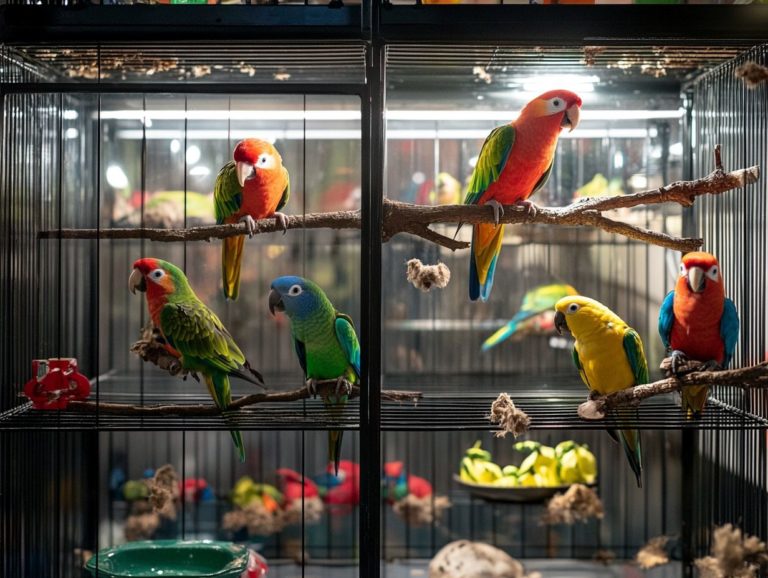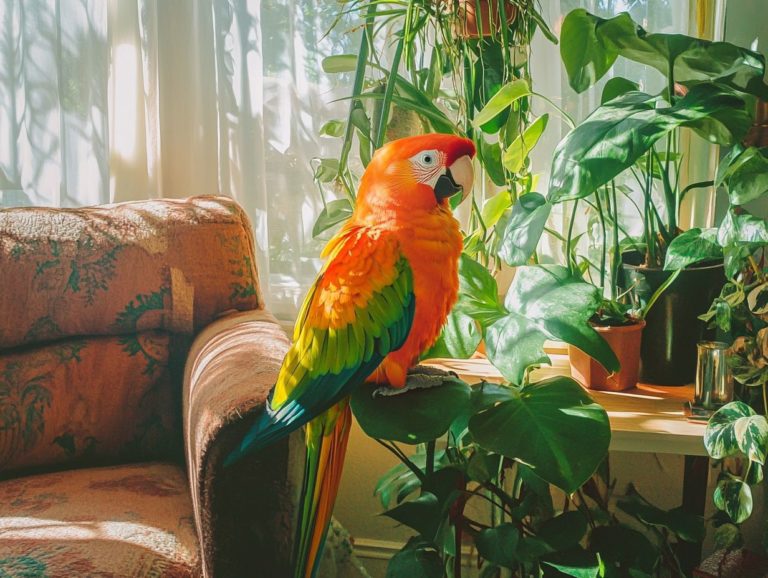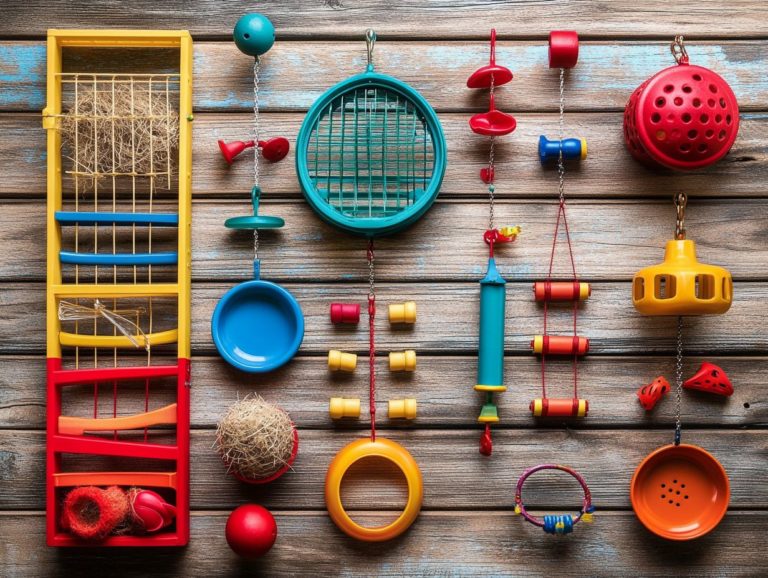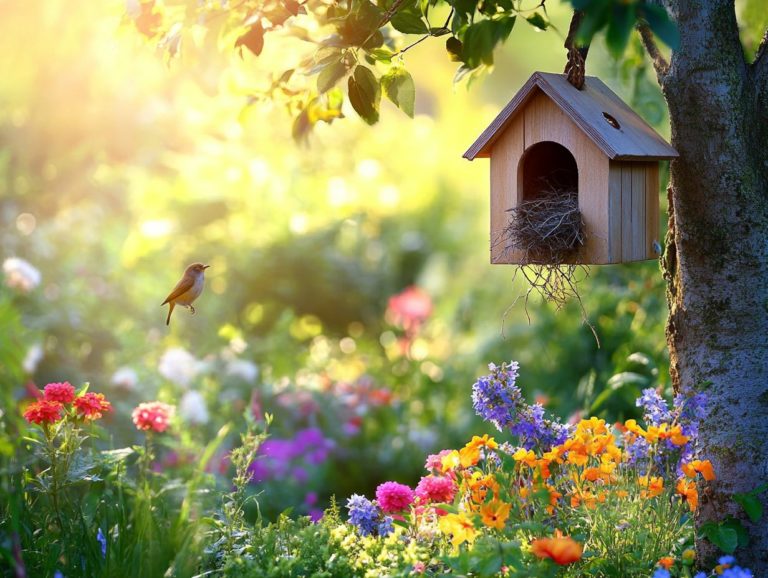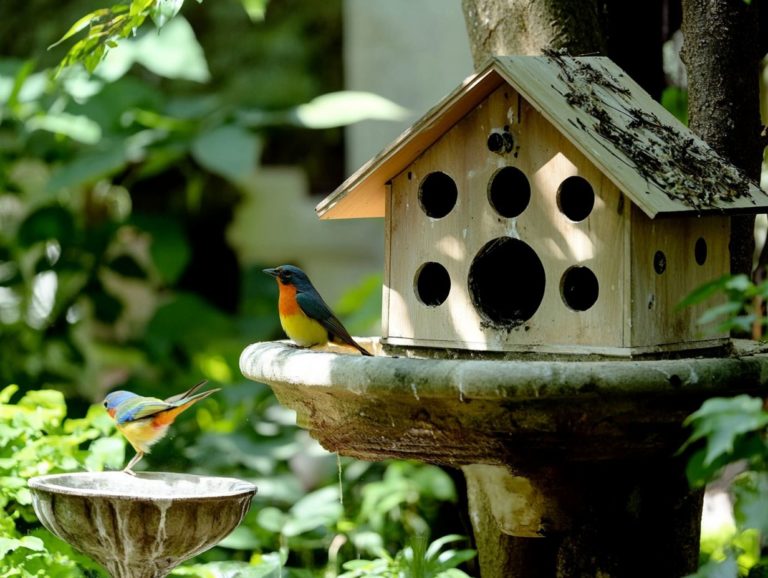Creating a Seasonal Setup for Your Bird
Creating a seasonal setup for your bird goes beyond looks. It enriches your pet s environment and aligns it with their natural instincts throughout the year. It also attracts wild birds to your backyard.
This article delves into the significance of seasonal setups. It guides you through the factors to consider when selecting the perfect bird feeding station and provides insights on how to transition your bird seamlessly.
You will discover innovative setup ideas and maintenance tips that will keep your feathered friend content and thriving all year long. Don t miss out on the transformative benefits a seasonal setup can bring to your bird! Discover how it can greatly enhance your pet’s quality of life.
Contents
- Key Takeaways:
- Why is a Seasonal Setup Important?
- Choosing the Right Seasonal Setup
- Preparing for Seasonal Changes
- Seasonal Setup Ideas
- Maintaining Your Bird’s Seasonal Setup
- Benefits of a Seasonal Setup for Your Bird
- Frequently Asked Questions
- What is a seasonal setup for birds?
- Why is it important to have a seasonal setup for your bird?
- How do I create a seasonal setup for my bird?
- What are some essential elements to include in a seasonal setup for your bird?
- How often should I update my bird’s seasonal setup?
- Are there any potential risks or challenges to consider when creating a seasonal setup for my bird?
Key Takeaways:
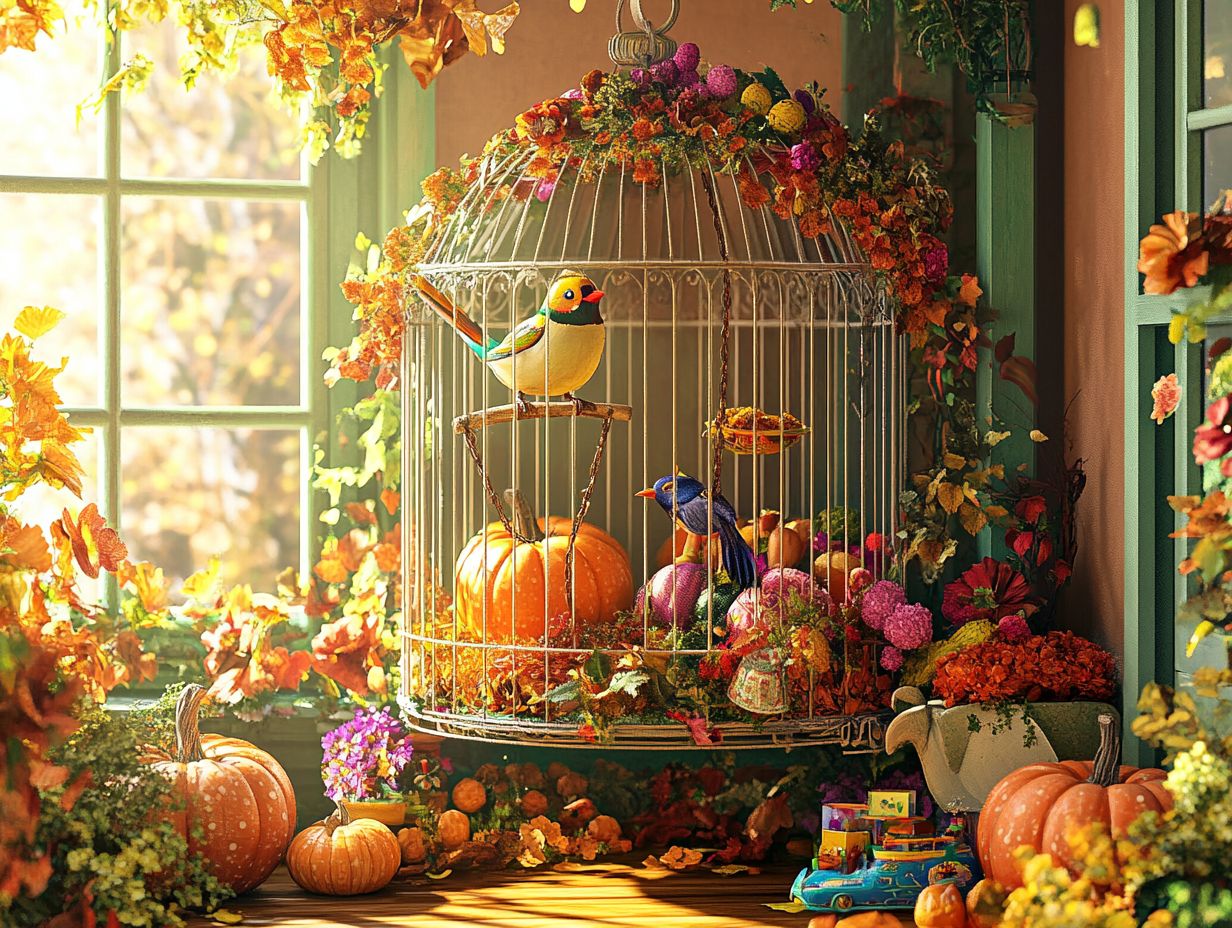
- Select a seasonal setup that meets your bird’s specific needs and current season, incorporating various bird feeders to enhance their feeding requirements.
- Properly transitioning your bird to a new setup can help minimize stress and ensure their safety and well-being.
- Maintaining a clean and safe seasonal setup can improve your bird’s overall health and happiness.
Why is a Seasonal Setup Important?
Creating a seasonal setup for your backyard birds is essential. It allows you to meet the specific feeding needs of various bird species year-round, including hummingbirds and cardinals. By adjusting your feeding stations with the changing seasons, you can draw in a vibrant array of wild birds, from melodic songbirds to dazzling hummingbirds.
These creatures depend on a well-maintained feeder and the right food sources to flourish in their natural habitat. Your commitment to this detail promotes their health and happiness and elevates your birdwatching experience to new heights.
Choosing the Right Seasonal Setup
Selecting the ideal seasonal setup for your bird feeding station requires a thoughtful approach. Consider the placement of feeders on poles and ground feeders. You’ll want to choose bird feeders that specifically cater to the species you aim to attract while taking into account the landscape of your property.
This includes thoughtfully incorporating native plants and various feeding arrangements such as birdhouses and bird baths to create an inviting environment for your feathered visitors.
Factors to Consider
When setting up a seasonal feeding setup, you need to consider several factors. Think about the types of bird feeders you’ll use, the specific feeding requirements of the birds in your area, and how to manage potential visitors like squirrels. Using a squirrel buster can be quite effective.
Placement of the feeders is another critical aspect. Positioning them near natural cover can give birds a sense of security while they dine. By selecting a variety of food options, such as seeds, suet, or nectar, you ll cater to the diverse avian population that visits your yard.
Regular maintenance is key, too. Cleaning feeders to prevent mold and refilling them promptly ensures the health of your feathered friends. For birdwatching enthusiasts, employing quiet observation methods and keeping a comfortable distance will elevate your experience, allowing you to enjoy moments of connection with nature while ensuring your feeding setup remains an inviting haven for wild birds.
Preparing for Seasonal Changes
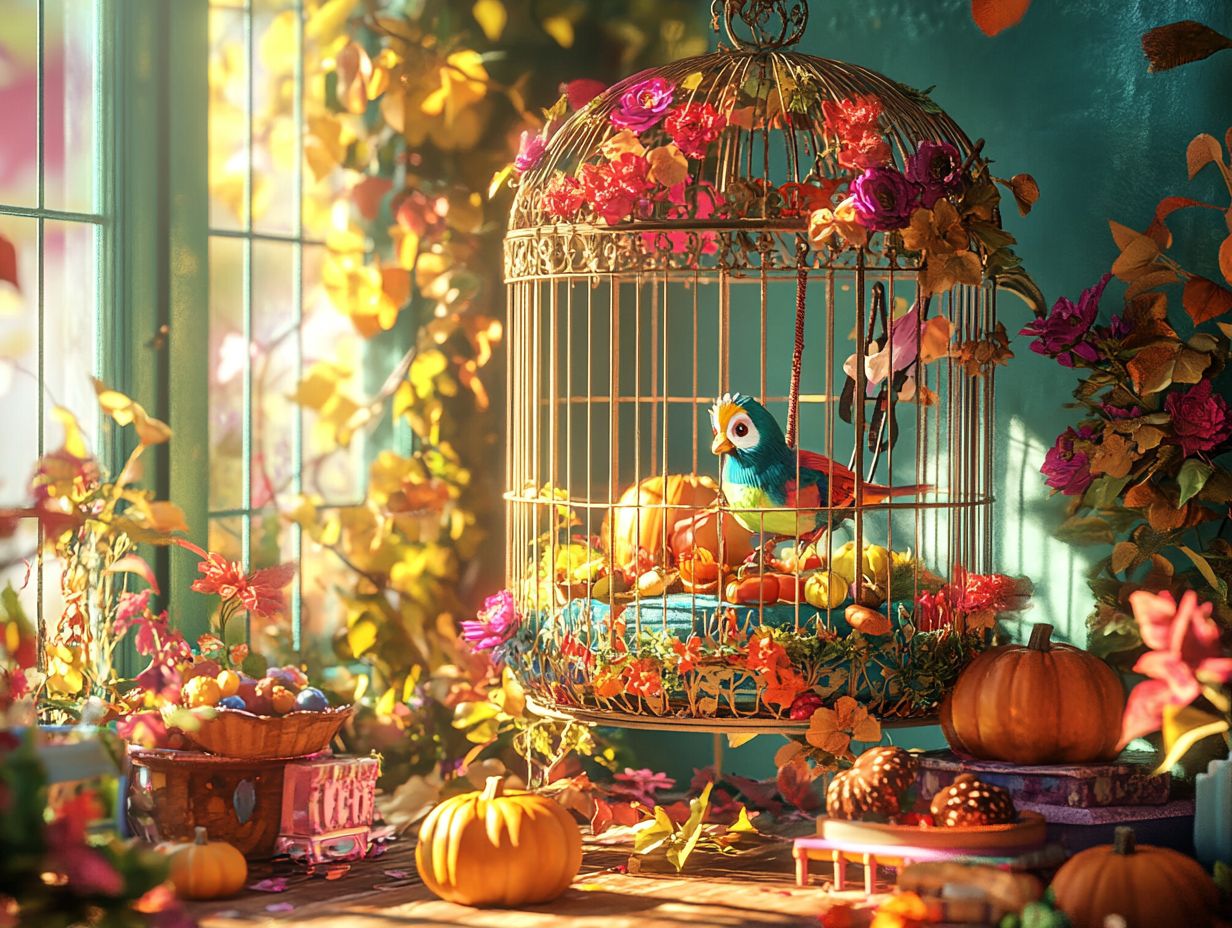
Preparing your backyard for seasonal changes means fine-tuning your bird feeding station. Make sure your bird baths are filled with fresh, clean water and understand the unique needs of various birds as they migrate or adjust their feeding habits throughout the year, such as Louisiana waterthrush and Henslow s sparrow.
Start preparing today and watch the joy your seasonal setup brings to your feathered friends!
Transitioning Your Bird to a New Setup
Transitioning your birds to a new feeding setup requires a careful approach. Ensure the bird feeder types are suited to the specific backyard birds visiting your property. Gradually introduce them to these changes in their familiar environment.
Start by observing the species that frequent your yard. Each bird has unique feeding preferences. For example, finches love nyjer seed (also known as thistle seed) served in tube feeders, while woodpeckers are usually attracted to suet in platform or cage feeders.
Introduce one type of feeder at a time, such as a Copper Seed Cylinder Feeder or Classic Deluxe Feeder. Allow the birds to adapt before adding more options. Experimenting with different food types can show you what truly entices your feathered friends! Monitor their behavior and make adjustments as needed to ensure they feel comfortable and secure in their new feeding setup.
Seasonal Setup Ideas
For your bird feeding station, there are numerous seasonal setup ideas to explore. Consider adding charming birdhouses to attract nesting birds. You can also strategically place feeders designed for specific species, like hummingbirds during migration seasons.
This enhances the beauty of your backyard and transforms it into a true sanctuary for birds!
Examples and Inspiration
Draw inspiration for seasonal setups by observing successful birdwatching enthusiasts. They expertly incorporate various bird feeders, refreshing bird baths, and native plants. These create inviting landscapes that attract a delightful range of birds.
Transform your backyard into a bird haven! Use a Ground Tray Recycled Feeder to attract various species. Pair tube feeders filled with sunflower seeds with suet feeders designed for energetic woodpeckers. Adding shallow birdbaths provides essential water sources during hot summer months.
Incorporate native flowering plants like coneflowers and milkweed to elevate your space’s visual appeal. This also invites pollinators and a variety of songbirds, including finches and warblers. Many birdwatchers have reported seeing more finches and warblers after making these thoughtful arrangements. This success encourages others to explore similar setups, fostering a vibrant avian community right in their own backyards!
Maintaining Your Bird’s Seasonal Setup
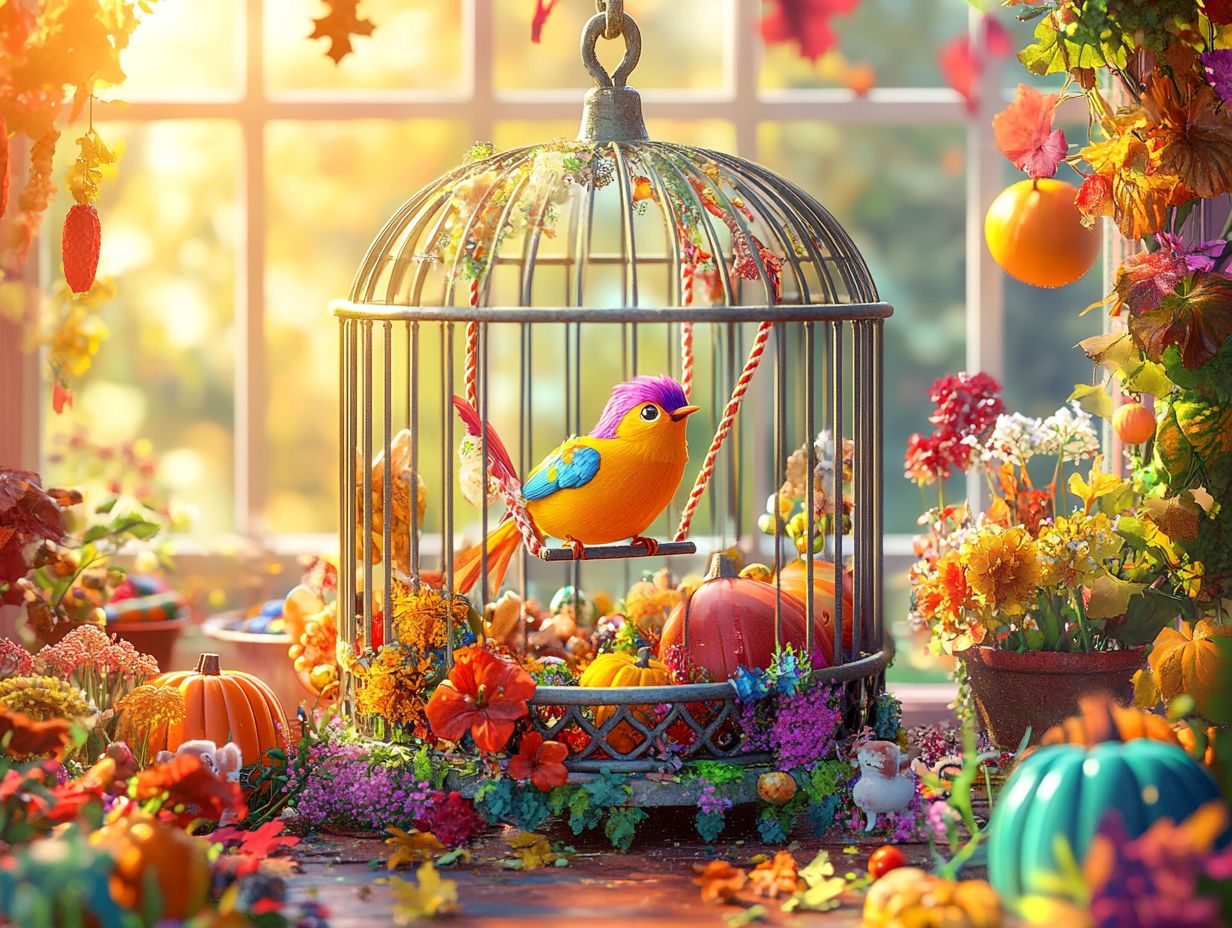
Maintaining your bird’s seasonal setup is crucial for attracting and nurturing the vibrant array of backyard birds. Regularly clean bird feeders and baths to provide healthy water and fresh food. This promotes the well-being of your feathered friends.
Keep an eye out for any wear or damage to your bird feeding station to maintain a welcoming environment for your feathered friends.
Tips for Keeping the Setup Clean and Safe
It s vital to keep your seasonal setup clean and safe for the well-being of your backyard birds. Regularly cleaning bird feeders and baths prevents mold and bacteria, ensuring they always have access to fresh water and nutritious food.
Aim to clean feeders and baths at least once a week, especially during warmer weather when bacteria tend to flourish. This ensures wild birds have consistent access to healthy water and nutritious food. A simple solution of hot water and a few drops of unscented liquid dish soap works wonders!
Use a stiff brush to reach tricky corners and crevices where residue may accumulate. Rinsing thoroughly is crucial; any lingering soap can be harmful to birds.
Make it a habit to replace the water in bird baths daily to keep them fresh and inviting. By prioritizing cleanliness, you re enhancing your setup and promoting the health of your feathered friends! This fosters a thriving, safe environment that encourages regular visits.
Benefits of a Seasonal Setup for Your Bird
The advantages of establishing a seasonal setup for your bird feeding station are abundant, especially when it comes to choosing the best food for various bird species. This approach enhances the health and happiness of different birds and elevates the birdwatching experience for enthusiasts who enjoy observing their feathered friends flourish in a carefully maintained environment.
Improving Your Bird’s Health and Happiness
You can elevate your bird’s health and happiness through a thoughtfully designed seasonal setup. Start by providing a variety of food that meets their specific dietary needs. Always have fresh water available, as it is essential for attracting birds throughout the year.
This setup ensures a safe and inviting environment that attracts various bird species year-round. To enhance their well-being, consider incorporating a blend of seeds, fruits, and vegetables tailored to their nutritional requirements. Remember, proper nutrition is vital for their vitality.
Don t overlook hydration consistent access to fresh, clean water is crucial for their overall health. Creating a secure environment is equally essential. Ensure they have a safe enclosure, avoid toxic plants, and minimize potential hazards. This fosters a sense of security, allowing your birds to thrive both emotionally and physically.
Engaging your birds with safe toys and suitable perches will promote their activity levels and happiness, enriching their experience in a well-maintained bird feeding station.
Frequently Asked Questions
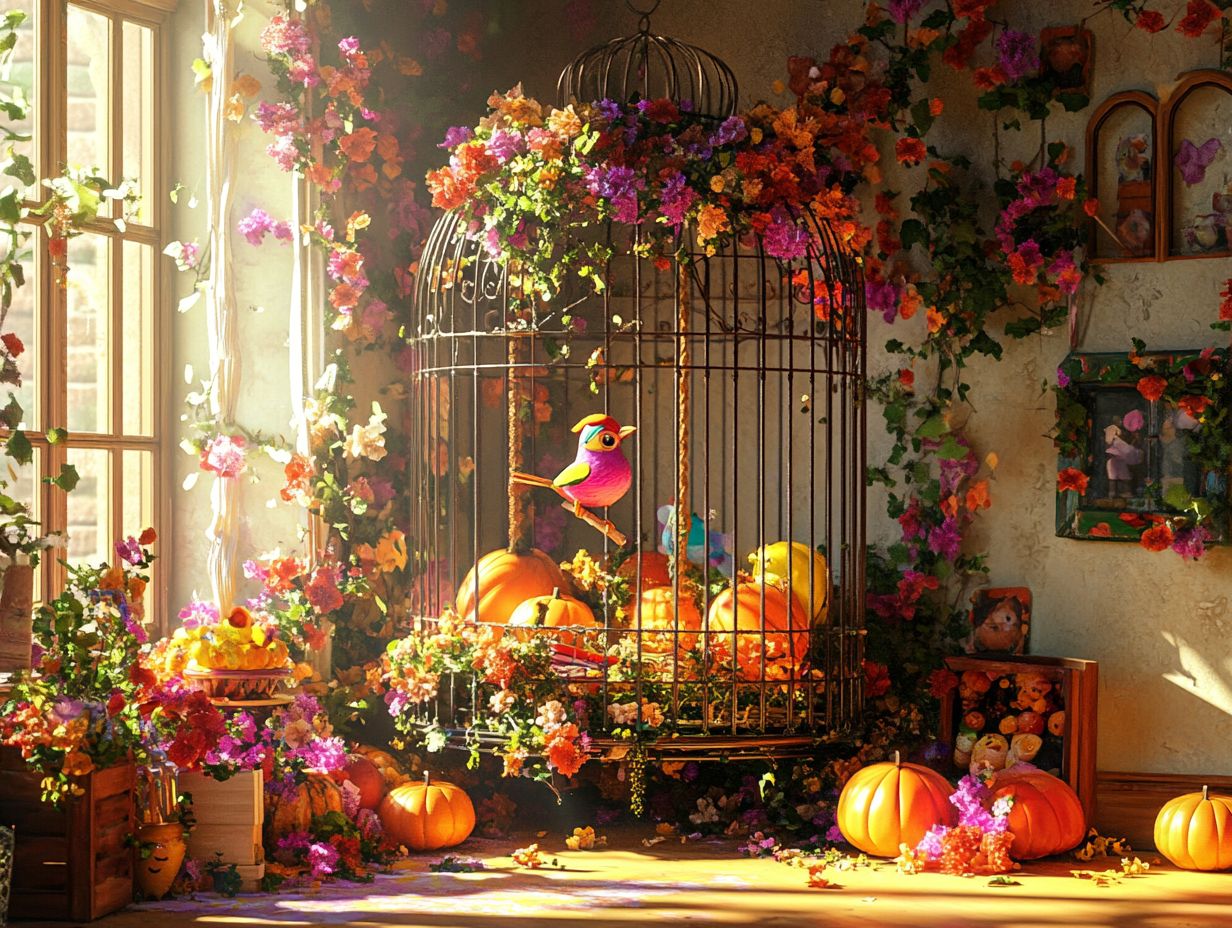
What is a seasonal setup for birds?
A seasonal setup for birds is a designated area specifically created for your bird to accommodate their natural behaviors and needs during different times of the year, which is essential for their well-being. For more insights, check out these seasonal health tips for your pet bird.
Why is it important to have a seasonal setup for your bird?
Having a seasonal setup allows your bird to be more comfortable and healthy by mimicking their natural environment and providing necessary resources throughout each season. For optimal care, consider creating a training schedule for your bird.
How do I create a seasonal setup for my bird?
To create a seasonal setup, research and understand your bird’s natural habitat and behaviors during each season. For guidance, consider recognizing and managing bird seasonal changes to provide appropriate temperature, lighting, food, and toys that mimic the changing seasons.
What are some essential elements to include in a seasonal setup for your bird?
Essential elements to include are a temperature-controlled environment, appropriate lighting, a variety of fresh and nutritious foods, and engaging toys and perches for enrichment.
How often should I update my bird’s seasonal setup?
The frequency of updates depends on your bird’s specific needs and behaviors. Observe your bird and make adjustments as needed, at least every few months.
Are there any potential risks or challenges to consider when creating a seasonal setup for my bird?
Yes, consider potential risks like changes in temperature or lighting that may affect their health. Providing appropriate toys is also crucial to prevent boredom and behavioral issues. Thorough research and consulting with a veterinarian or avian specialist can ensure your bird’s safety and well-being.
Act now to ensure your bird s happiness by creating a seasonal setup tailored to their needs!


